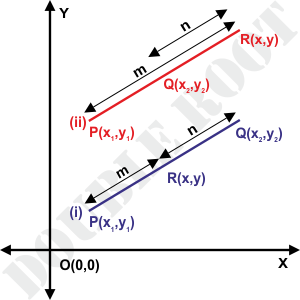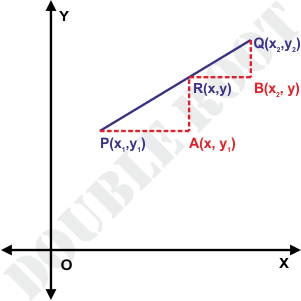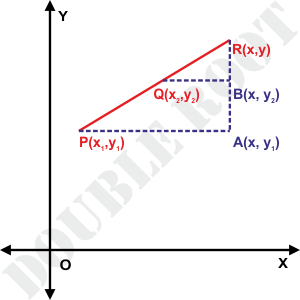In this lesson, we’ll establish the formula to find the coordinates of a point, which divides the line segment joining two given points in a given ratio. The formula is known as the Section Formula. Let us begin!
Consider two points P(x1, y1) and Q(x2, y2). We have to find the coordinates of the point R which divides PQ in the ratio m : n, i.e. PR / RQ = m / n.
Given the ratio, the point R can either lie between P and Q, or outside the line segment PQ. Have a look.

(Note that in the above figure, m and n do not denote the lengths of PR and QR. They are just indicating the ratio.)
Let’s consider these cases one by one.
Case I – R lying between P and Q
I’ll first illustrate an ugly (but valid) method to compute the coordinates of R, by using what we already know – the distance formula. As I mentioned earlier, there are (in general) multiple methods to solve a coordinate geometry problem. This is one of those cases. The idea is to develop your thinking level, and give you an idea of which methods are good and which aren’t.
Here’s one way you can think: “Since there are two unknowns x and y (i.e. the coordinates of R), I need to find two equations, or two geometric conditions, which I’ll convert into (solvable) equations, using the formulas I know.”
Hmm.. one condition is already given, PR / RQ = m / n, or n.PR = m.RQ. So, we can write
\( \small n\sqrt{(x-x_1)^2+(y-y_1)^2}=m\sqrt{(x_2-x)^2+(y_2-y)^2}\)
It’s already starting to get ugly.
What about the next condition? The first condition does not ensure that P, R, and Q will lie on the same line. So, we have our second condition, PR + RQ = PQ. We get an even more ugly equation:
\( \small \sqrt{(x-x_1)^2+(y-y_1)^2}+\sqrt{(x_2-x)^2+(y_2-y)^2}=\sqrt{(x_2-x_1)^2+(y_2-y_1)^2}\)
I’ll stop here. You might have got the idea why this is not the best method. In fact, as we’ll see later on, methods involving distance formula generally get quite complicated and difficult to solve.
So what is our alternative? Time for a little geometry – let’s make some constructions.

I’ve drawn RA and QB parallel to the Y axis, and PA and RB parallel to the X axis. Then, the triangles RPA and QRB are similar, by AA similarity.
How does this help? We are given PR / QR, which, using similarity, is equal to RA / QB and PA / RB. Let me write this in a better way:
\(\frac{PR}{QR} = \frac{ RA}{QB} = \frac{PA}{RB} = \frac{m}{n}\)
Now, PA = x – x1 and RB = x2 – x (I’ve provided explanation for this in a previous lesson.)
Therefore, we can write
\(\frac{PA}{RB}=\frac{x-x_1}{x_2-x}=\frac{m}{n}\)
On solving the above for x, we get
x = \(\frac{mx_2+nx_1}{m+n}\)
What about y?

Referring to the figure above, RA = y – y1 and QB = y2 – y.
Now, we can use the same process to get
y = \(\frac{my_2+ny_1}{m+n}\)
And so we have the coordinates of the point R, which divides PQ in the ratio m : n.
When R lies between P and Q, we say that R divides PQ in the ratio m : n internally. Here’s a simulation that shows two points A and B, and the point C dividing the line segment joining them in some ratio.
Try changing the values of m and n, and observe the coordinates of C. Do you get the same coordinates using the section formula?
Let’s see what happens when R lies outside PQ.
Case II – R lying outside PQ
The given condition is the same, i.e. PR / RQ = m / n, but the figure will be a little different.

In this case, we say that R divides PQ externally in the ratio m : n.
I’m not going to derive this one. Please try to do it yourself. The method is the same as in the first case – find the similar triangles, express the given ratio in terms of x1, x2, y1, and y2.
If you do it right, you should get
x = \( \frac{mx_2-nx_1}{m-n}\)
y = \( \frac{my_2-ny_1}{m-n}\)
Lesson Summary
- The coordinates of the point dividing the line segment joining (x1, y1) and (x2, y2) in the ratio m : n internally is given by \(\left ( \frac{mx_2+nx_1}{m+n} , \frac{my_2+ny_1}{m+n} \right ) \)
- The coordinates of the point dividing the line segment joining (x1, y1) and (x2, y2) in the ratio m : n externally is given by \(\left ( \frac{mx_2-nx_1}{m-n} , \frac{my_2+ny_1}{m+n} \right ) \)
Well, that’s it. See you in the next lesson with some examples and applications of the section formula!